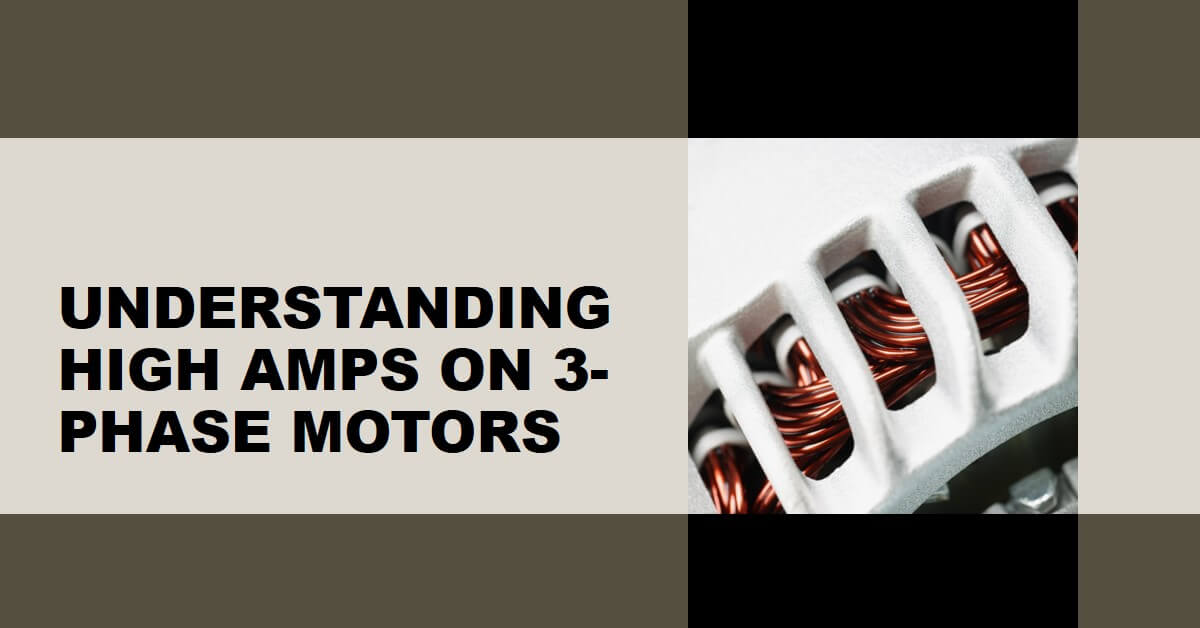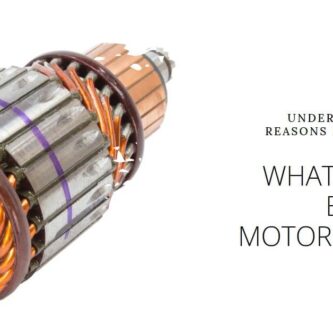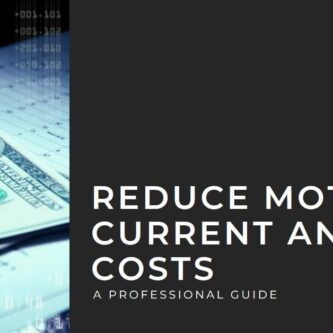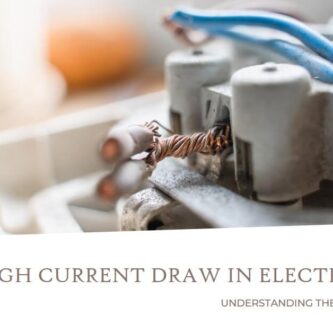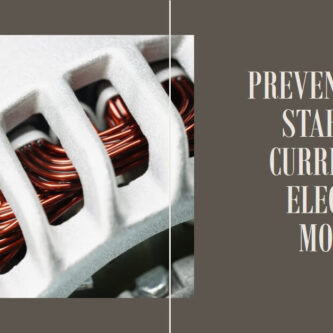Image: “Article Feature Image” by Bing is licensed under CC BY-NC-SA 4.0. Source: Bing Graphic Art. License: CC BY-NC-SA 4.0.
Three-phase motors are commonly used in various industrial applications due to their efficiency and reliability.
They provide smooth power delivery and are capable of handling heavy loads. However, it is important to understand the causes and implications of high amps in these motors to ensure their optimal performance and prevent potential damage.
High amps on a 3-phase motor can result from a combination of electrical and mechanical issues. Electrical issues such as voltage imbalance occur when the voltages in the three phases differ significantly, leading to uneven distribution of the electrical load.
Importance of Understanding High Amps
High amperage in a 3-phase motor can indicate underlying issues that may lead to motor failure, increased energy consumption, or even safety hazards.
By understanding the causes of high amps, operators and maintenance personnel can identify and resolve problems promptly, minimizing downtime and optimizing motor performance.
Basics of 3-Phase Motors
Definition and Function
A 3-phase motor operates on a three-phase power supply, which consists of three alternating currents that are 120 degrees out of phase with each other.
This design provides a continuous and smooth power flow, resulting in efficient motor operation.
The motor converts electrical energy into mechanical energy to perform various tasks, such as driving pumps, compressors, or industrial machinery.
Components and Working Principles
A typical 3-phase motor consists of three main components: a stator, a rotor, and an enclosure. The stator contains stationary windings, which generate a rotating magnetic field when energized.
The rotor, placed inside the stator, consists of conductive bars or windings that interact with the magnetic field to produce torque and rotation.
The enclosure protects the motor and houses auxiliary components like bearings and cooling systems.
Understanding Amps in 3-Phase Motors
Definition of Amps
Amps, short for amperes, is the unit of measurement for electric current. In the context of 3-phase motors, amps refer to the current flowing through each phase of the motor during operation.
It is an important parameter to monitor as it indicates the electrical load on the motor and helps identify any abnormalities.
Normal Operating Amps for 3-Phase Motors
Every motor has a rated ampacity specified by the manufacturer, indicating the maximum current it can safely handle under normal operating conditions.
Deviations from this rated ampacity can suggest potential issues in the motor or its electrical supply.
Impact of High Amps
High amperage in a 3-phase motor can have several negative consequences. It can lead to excessive heat buildup, potentially damaging the motor’s windings, insulation, or other components.
Moreover, high amps indicate increased energy consumption, which can result in higher operating costs.
In extreme cases, sustained high amps can cause motor burnout or even electrical hazards, posing a risk to equipment and personnel.
Common Causes of High Amps in 3-Phase Motors
Electrical Issues
- Voltage Imbalance Voltage imbalance occurs when the voltages in the three phases of the motor differ significantly. This imbalance can cause an uneven distribution of the electrical load, resulting in increased amps in one or more phases.
- Voltage Drop Voltage drop refers to the reduction in voltage along the electrical supply lines. Excessive voltage drop can increase the motor’s current draw, leading to higher amps.
- Overvoltage When the voltage supplied to the motor exceeds the rated voltage, it can cause increased current flow, resulting in high amps.
- Under-voltage Insufficient voltage supply can lead to increased current demand from the motor, causing higher amps.
- Phase Loss A phase loss occurs when one of the three phases of the motor’s power supply is interrupted. The remaining phases may compensate by drawing higher currents, resulting in elevated amps.
- Incorrect Connections Incorrectly connected wiring, such as reversed or swapped phases, can cause imbalances in the motor’s electrical system, leading to high amps.
- Faulty or Damaged Wiring Faulty or damaged wiring can increase resistance in the electrical circuit, resulting in higher current flow and increased amps.
Mechanical Issues
- Overload Overloading a motor by operating it beyond its designed capacity can cause an excessive current draw, resulting in high amps. This can occur due to increased load demands or mechanical issues within the motor.
- Misalignment of the motor and the driven equipment can cause mechanical stress, resulting in increased friction and higher amp draw.
- Bearing Problems Worn or faulty bearings can increase the motor’s mechanical resistance, leading to higher amps during operation.
- Impeller or Fan Blade Issues Damaged or improperly balanced impellers or fan blades can cause the motor to work harder, resulting in increased current draw.
- Coupling or Belt Problems Worn or misaligned couplings or belts can impose additional load on the motor, causing it to draw higher amps.
Troubleshooting High Amps in 3-Phase Motors
Steps to Identify the Cause
When encountering high amps in a 3-phase motor, it is essential to follow a systematic troubleshooting approach.
This includes identifying and isolating the electrical or mechanical factors contributing to the issue.
Electrical Troubleshooting Techniques
Electrical troubleshooting involves checking for voltage imbalances, measuring voltage drops, inspecting wiring connections, and verifying proper phase voltages.
Advanced diagnostic tools like power quality analyzers can assist in identifying and rectifying electrical issues.
Mechanical Troubleshooting Techniques
Mechanical troubleshooting focuses on inspecting mechanical components such as bearings, couplings, belts, and alignment.
Techniques may include visual inspection, vibration analysis, and temperature monitoring to identify any anomalies.
Importance of Regular Maintenance
Regular maintenance plays a vital role in preventing high amps in 3-phase motors. Periodic inspections, cleaning, lubrication, and alignment checks help ensure optimal motor performance and early detection of potential issues.
Following manufacturer-recommended maintenance schedules can significantly reduce the likelihood of high amp occurrences.
Prevention and Maintenance Strategies
Electrical Maintenance Implementing measures such as voltage monitoring, load balancing, and surge protection can help prevent high amps caused by electrical issues.
Regular inspections of wiring connections, insulation, and grounding systems are crucial for maintaining a reliable electrical supply.
Mechanical Maintenance Scheduled inspections, lubrication, and alignment checks are essential to prevent mechanical issues that contribute to high amps.
Monitoring bearing conditions, vibration levels, and temperature can provide early warning signs of impending problems.
Monitoring and Safety Measures Utilizing motor protection devices like overload relays and thermal sensors can help prevent excessive current draw and protect the motor from damage.
Installing power quality monitoring systems allows for continuous monitoring of voltage levels, currents, and other electrical parameters, facilitating timely identification of potential high amp situations.
Conclusion
Understanding the causes of high amps in 3-phase motors is crucial for maintaining optimal performance, preventing motor failures, and ensuring safe operation.
By addressing electrical and mechanical issues promptly, following proper troubleshooting techniques, and implementing regular maintenance practices, operators can mitigate the risks associated with high amps and maximize the lifespan and efficiency of 3-phase motors.
you work With Electricity! Don’t leave empty-handed!
Looking to stay ahead of the game in the world of electrical engineering? Subscribe to my YouTube channel and gain access to exclusive content you won’t find anywhere else!
The staff I recommend (Amazon Affiliate Links to products I believe are high quality):
- Economy 120 Volt/60Hz AC Power Source – Step-Down Voltage & Frequency Converters 1800W
- UNI-T Digital Multimeter Tester UT139C
- 50-Amp Extension Cord for RV “100ft”
- Voltage Stabilizer 110/220v
- Hair Dryer “best selling“
- TOSHIBA EM131A5C-BS Countertop Microwave Ovens
Disclaimer: This contains affiliate links to Amazon products. I may earn a commission for purchases made through these links.

